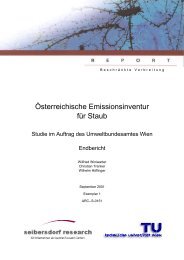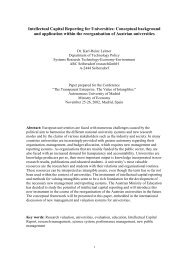ALPMON FINAL REPORT - ARC systems research
ALPMON FINAL REPORT - ARC systems research
ALPMON FINAL REPORT - ARC systems research
Create successful ePaper yourself
Turn your PDF publications into a flip-book with our unique Google optimized e-Paper software.
Contract ENV4-CT96-0359 <strong>ALPMON</strong><br />
2.3.1.3.7 Task: Planning Recreation Activities<br />
The data described up to now allow a landscape assessment to find suitable areas for different tourism<br />
activities. For example, the information about aspect and slope together with additional geological<br />
information can help to find new places for ski runs or ski lifts.<br />
In our area we took a closer look at the hiking tourism. A hiking information system was created. New<br />
hiking routes can be chosen and described with the aid of GIS and remote sensing data. This hiking<br />
information system can be used by the Tourism Administration to find out new route advises or it can<br />
be used by the tourists themselves for planning their tour for the day. Hiking tourists can choose new<br />
routes independently of the suggestions of the Tourist Office and get information like way length,<br />
altitude profile, aspect or forest or open area along the trail.<br />
2.3.2 Modelling of Water Run Off, Mangfall and Sulm Test Sites (LMU, JR)<br />
2.3.2.1 Introduction and Objectives<br />
All land utilisation changes, irrespective of whether they are the result of set aside policies, or damage<br />
to forests, e.g. uprooted trees due to gale-force winds, are likely to effect the hydrological cycle and the<br />
quality of the water. Liebscher (1991) further stated that regional climatic changes may also have an<br />
impact on the hydrologic balance of surface waters in Central Europe. In alpine areas increases in<br />
temperatures are expected to affect snow melt periods and also the altitudes up to which snow is likely<br />
to melt, which again is likely to represent an additional hazard potential, as e.g. due to higher volumes<br />
of runoff.<br />
The hydrological problems to be solved or at least bypassed are identified by Braun et al., (1997) to be<br />
related to the extreme heterogeneity of surface and underground to be handled. Consequently<br />
hydrological models require very different parameters like duration, intensity and sequence but also the<br />
cluster and cell size for precipitation, water net structure, topography/relief, land use, soil and<br />
geological characteristics.<br />
Alpine conditions represent a special challenge for water run off modelling. The complexity of the<br />
interrelations between interception by vegetation coverage, infiltration into the soil, surface run off,<br />
precipitation history, temperature, snow coverage and snow melt u.s.o., as well as the effects of soil<br />
condition changes (e.g. soil pore volume changes) following the defined reduction of crown coverage<br />
by selective logging have been studied in detail over a time period of around ten years in the frame of a<br />
<strong>research</strong> project funded by the German Ministry of Research and Technology (Breitsameter et al. ,<br />
1993, Breitsameder, 1996, Moeschke, 1998).<br />
Further important aspects are data acquisition and processing as well as data preparation (analysis,<br />
filtering, regional adaptation), i.e. the entire range of tasks from pre-processing to the development of<br />
files for model-specific parameters and records. One of the reasons for this emphasis on the<br />
availability of data is that many of the available models have proved unsuitable for practical<br />
applications because data was not sufficiently available. It would therefore be advantageous if in future<br />
only models were used which can be easily adapted to any given catchment area and do not require<br />
lengthy and costly periods of data measurement and acquisition before each new application.<br />
Generally, precipitation-runoff-models like TOPMODEL (Beven, 1994) or WaSiM-ETH (Schulla, 1997)<br />
are used to describe run-off patterns as well as material displacement caused by erosion-inducing<br />
precipitation in medium-scale catchment areas (AGNPS 3.65 - Agricultural Non-Point Source Pollution<br />
Model (Young et al., 1989); GAME - GIS - supported run-off model based on precipitation events;<br />
Bayerisches Landesamt für Wasserwirtschaft, LfW). They are employed to describe current water and<br />
material movement, to predict future movement patterns and to forecast specific events (floods).<br />
ASGI, german Abfluß (water run-off), Stofftransport- (material displacement) Modellierung (modelling),<br />
using Geo Information Systems, is a complex, modular based hydrological model which is based on<br />
the TOPMODEL approach and is integrated in a GIS environment. It belongs to the group of<br />
“distributed models”. ASGI is developed to calculate run off processes and solid matter fluxes in mesoscale<br />
hydrological catchments with high temporal and spatial resolution. ASGI describes in grid<br />
elements the components of water cycle and facilitates to model decisive processes of the precipitation<br />
run off as following (Molnár & Kasper 1998), e.g.:<br />
� interpolation of point coded meteorological input data to be implemented in grid data model<br />
� storage of water by soil and vegetation and the resulting reduction of evaporation<br />
JR, RSDE, ALU, LMU, Seibersdorf, WSL 31




